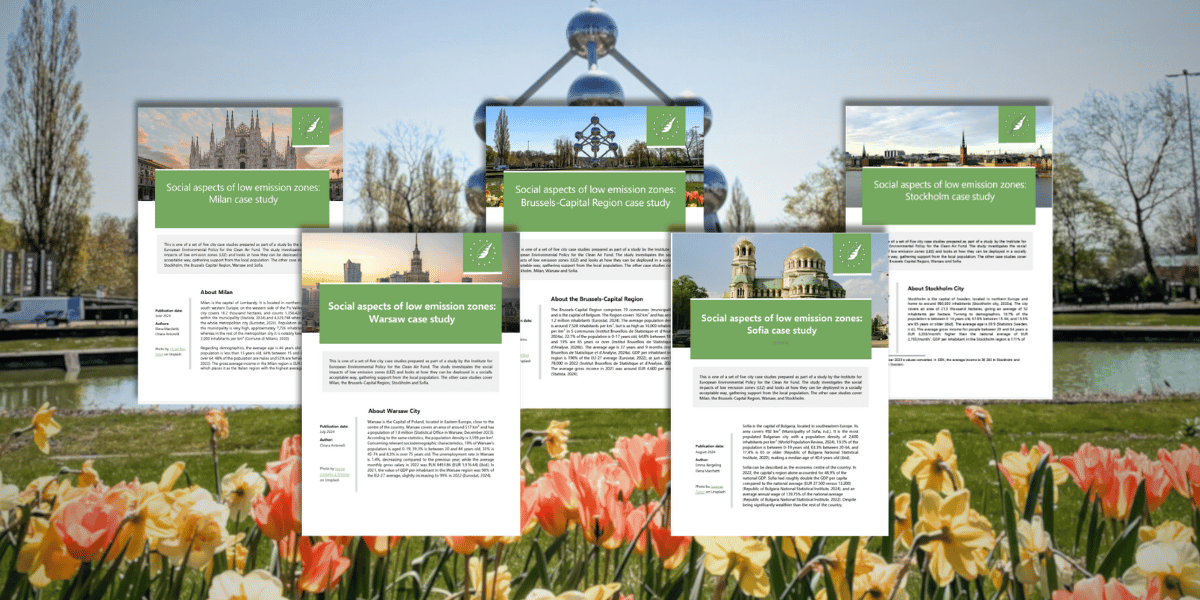AUTHORS: Emma Watkins, Emma Bergeling, Elena Marchetti, Chiara Antonelli
Low emission zones (LEZ) and zero emission zones (ZEZ) are important tools to help cities to improve their air quality and address associated health impacts. However, their introduction can sometimes be controversial and met by resistance from the public and businesses, who fear the possibility of costly, inconvenient or unequal socio-economic impacts. So, what can cities do to get their citizens and businesses on board?
IEEP has prepared set of case studies on LEZ in EU cities, as part of a study for the Clean Air Fund. The LEZ in the three cities for which case studies were published in June – Stockholm, Milan and Brussels – are well-established (initially introduced in 1996, 2008 and 2018 respectively). The case studies reveal some common threads related to how cities can engage and communicate with stakeholders when developing a LEZ, and how they can address some of the potential socio-economic impacts during the LEZ’s implementation. The two final case study cities Warsaw and Sofia are breaking new ground as they are currently implementing the first LEZs in Eastern Europe.
Here we highlight some of these emerging findings of these briefings, which together will feed into the study’s final research paper.
Firstly, cities should be prepared to face some initial resistance to introducing an LEZ – they’re certainly not always an election-winning policy. Citizens can’t be expected to be immediately supportive, especially if the LEZ is new and untested. However, policy-makers should be willing to take the political risk, explain and demonstrate the practical benefits to citizens, and build support through consultation and communication processes.
Stakeholder consultation and engagement is crucial during the development of a LEZ, and also when planning any changes. The more extensive, detailed and inclusive the consultation, the better. Stockholm, Milan, Warsaw and Brussels have all used different methods, such as written questionnaires, roundtables, consultation of a citizens’ panel, public debates, or even face-to-face meetings with specific businesses or individuals. The key is to explain, discuss, listen – and take on board the opinions of the consulted groups in the LEZ’s design.
It is also critical to continue communication efforts during the implementation of the LEZ. This can be particularly helpful when there upcoming changes, such as restrictions for additional vehicle types or the exclusion of vehicles with higher Euro emission standards. Complementary communication on the air quality impacts of the LEZ through regular reporting (in the case of Milan), or even citizen science projects (such as the CurieuzenAir initiative in Brussels that directly involved the public in air quality monitoring) can also help to demonstrate the benefits and enhance support for the LEZ.
Developing a clear and transparent timeline specifying future steps in advance is also extremely helpful. For example, the future restrictions for higher Euro emission standard vehicles are already laid out for the Brussels LEZ through to 2035. This provides predictability for businesses and citizens and can also encourage ‘pre-compliance’, such as getting rid of affected vehicles before new restrictions are introduced.
When placing restrictions on mobility by limiting the access of certain vehicles to a city, it’s vital to ensure the provision and promotion of alternative forms of mobility. These should be clean, accessible and affordable, so they support the air quality objectives of the LEZ whilst also providing mobility to all those who need it. Stockholm, Milan and Brussels have all improved alternatives, including public transport, bike- and car-sharing and electric vehicle charging infrastructure. Cities should provide citizens with information and advice on these alternatives.
Allowing reasonable, limited exemptions can also help to increase public acceptability and limit impacts on those who have no viable alternative to private transport, or only occasionally need to enter the LEZ. For example, Stockholm, Milan, Warsaw and Brussels all have exemptions for vehicles used to transport people with disabilities, whilst the Brussels LEZ allows the purchase of a limited number of day passes for non-compliant vehicles, and in Milan owners of certain vehicles or residents in specific areas are granted a certain number of free accesses to the LEZ.
Finally, providing complementary measures – including financial support – can help to ensure fairer implementation of an LEZ. Examples from Brussels include financial support for citizens (Bruxell’Air bonus) and businesses (Low-emission mobility allowances), which include higher levels of support for lower-income households and SMEs, whilst in Milan incentives are provided for businesses and citizens to purchase less-polluting vehicles.
A webinar titled, “Low Emission Zones: Navigating the Social Challenges of Clean Air Policies in EU Cities,” will be organised on September 9th. This event marks the end of a project on the social impacts of Low Emission Zones in EU cities and will present key findings from IEEP’s final research paper.
Webinar: Low Emission Zones: Navigating the Social Challenges of Clean Air Policies in EU Cities
- Monday 9 September, 14.00 – 15.30
- Online
- Register here
Read our policy briefs

